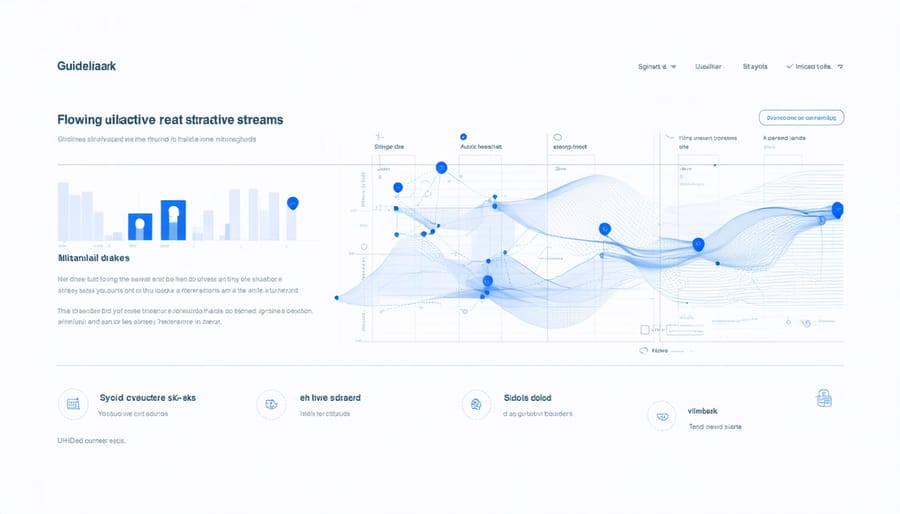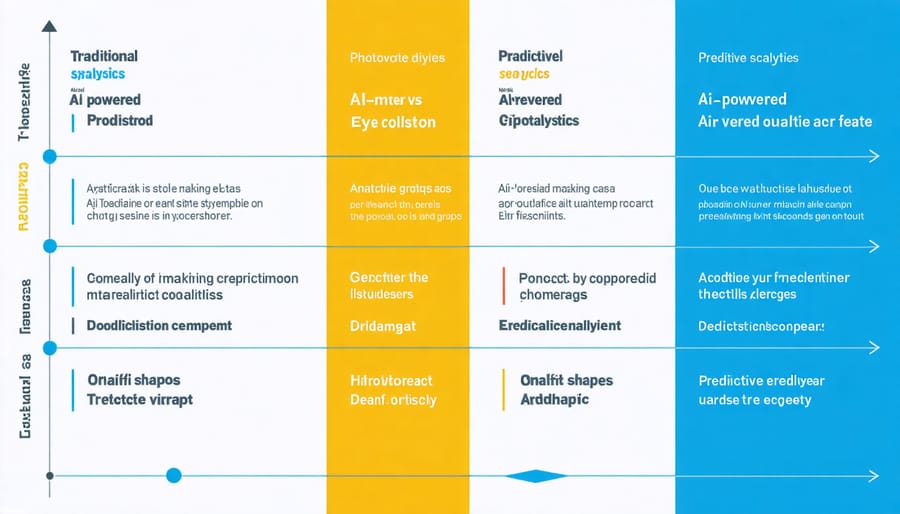In today’s data-driven business landscape, the intersection of analytics and decision-making has become the cornerstone of competitive advantage. Organizations that harness the power of business analytics consistently outperform their peers, making faster, more accurate decisions that drive measurable results. From predictive modeling that forecasts market trends to real-time dashboards that monitor operational efficiency, business analytics transforms raw data into actionable insights that shape strategic direction and tactical execution.
Modern decision-makers face an unprecedented volume of data, making the ability to extract meaningful patterns and insights more crucial than ever. By leveraging advanced analytics tools and methodologies, businesses can now identify hidden opportunities, mitigate risks, and optimize operations with remarkable precision. This systematic approach to decision-making reduces reliance on gut feelings and replaces intuition with data-backed confidence.
The true value of business analytics lies not just in gathering data, but in creating a decision-making framework that seamlessly integrates analytical insights into daily operations. Successful organizations are those that build a data-driven culture, where every decision, from strategic initiatives to routine operations, is informed by robust analysis and supported by concrete evidence. This transformation from traditional decision-making to analytics-powered insights represents not just a technological shift, but a fundamental change in how modern businesses operate and compete.
How AI is Revolutionizing Business Analytics
Real-Time Data Processing and Analysis
Real-time data processing has revolutionized how businesses make decisions by enabling instant analysis of vast data streams as they flow into the system. Modern AI systems can process millions of data points per second, transforming raw information into actionable insights without delay.
Consider an e-commerce platform during a flash sale: AI algorithms simultaneously track customer behavior, inventory levels, pricing dynamics, and website performance. This real-time processing allows the system to make immediate adjustments, such as automatically restocking popular items, adjusting prices based on demand, or redirecting server resources to prevent crashes.
The process typically involves three key stages: data ingestion, where information is collected from various sources like IoT devices, social media feeds, and transaction systems; stream processing, where AI algorithms analyze the incoming data for patterns and anomalies; and immediate response generation, where the system produces actionable recommendations or automated responses.
Machine learning models continuously learn and adapt from this real-time data flow, improving their accuracy over time. For instance, a financial trading system can analyze market trends, news feeds, and social sentiment simultaneously, adjusting investment strategies within milliseconds based on changing conditions.
Businesses leverage this capability through dashboards and automated alert systems that provide instant visibility into operations, enabling quick responses to emerging opportunities or potential problems. This real-time insight has become particularly crucial in industries where conditions change rapidly, such as manufacturing, logistics, and customer service.

Predictive Analytics and Forecasting
In today’s data-driven business landscape, predictive analytics has become a game-changer for organizations seeking to make informed decisions about their future. By leveraging advanced predictive analytics tools and machine learning algorithms, businesses can now forecast trends, anticipate customer behavior, and identify potential risks with remarkable accuracy.
These predictive capabilities work by analyzing historical data patterns and current market conditions to generate insights about future outcomes. For example, retailers can predict seasonal demand fluctuations, helping them optimize inventory levels and reduce waste. Financial institutions use these technologies to assess credit risks and detect fraudulent activities before they cause significant damage.
The power of predictive analytics lies in its ability to process vast amounts of structured and unstructured data from multiple sources. Modern systems can analyze everything from social media sentiment to economic indicators, weather patterns, and consumer purchasing histories to create comprehensive forecasting models.
Consider a manufacturing company that uses predictive maintenance to anticipate equipment failures before they occur. By analyzing sensor data and historical maintenance records, the system can alert technicians to potential issues, reducing downtime and maintenance costs. Similarly, marketing teams can predict customer churn by analyzing engagement patterns and implementing retention strategies before customers leave.
The key to successful implementation is choosing the right tools and ensuring data quality. When properly deployed, these systems can provide organizations with a significant competitive advantage through more accurate forecasting and proactive decision-making.

Key Components of AI-Driven Decision Making
Machine Learning Algorithms
In modern business analytics, understanding machine learning fundamentals is crucial for making data-driven decisions. Several key algorithms have proven particularly valuable in business applications. Regression algorithms, including linear and logistic regression, help predict numerical outcomes and classify data, making them ideal for sales forecasting and customer churn prediction.
Decision trees and random forests excel at breaking down complex decisions into simple, logical steps. These algorithms are particularly useful for customer segmentation and risk assessment, as they provide clear visual representations of the decision-making process.
Clustering algorithms, such as K-means, help businesses identify natural groupings within their data. This is particularly valuable for market segmentation and customer behavior analysis, allowing companies to tailor their strategies to specific customer groups.
Support Vector Machines (SVM) and Neural Networks handle more complex patterns in data. While SVMs are excellent for classification tasks like fraud detection, neural networks excel at processing unstructured data such as customer feedback and market trends.
Time series analysis algorithms are essential for businesses tracking performance metrics over time, enabling accurate forecasting of seasonal trends and market demands. These algorithms help organizations anticipate future needs and optimize resource allocation.
Each algorithm serves specific business needs, and choosing the right one depends on the problem at hand, data quality, and desired outcomes.

Natural Language Processing
Natural Language Processing (NLP) has revolutionized how businesses extract valuable insights from unstructured data like customer reviews, social media posts, emails, and support tickets. By enabling computers to understand and analyze human language, NLP transforms raw text into actionable business intelligence.
Consider a customer service department receiving thousands of support tickets weekly. NLP algorithms can automatically categorize these tickets by topic, urgency, and sentiment, helping managers identify recurring issues and optimize resource allocation. Similarly, marketing teams use NLP to analyze social media conversations, understanding customer preferences and monitoring brand reputation in real-time.
One of the most powerful applications of NLP in business analytics is sentiment analysis. By detecting the emotional tone in customer feedback, companies can track satisfaction levels, identify potential crisis points, and measure the impact of new initiatives. For example, a retail chain might use sentiment analysis to evaluate customer reactions to a new store layout across multiple locations.
NLP also enhances decision-making through text summarization and topic modeling. Executives can quickly digest large volumes of reports, news articles, and market research, focusing on the most relevant information. This capability is particularly valuable in competitive intelligence, where staying updated on market trends and competitor activities is crucial.
Recent advances in NLP, particularly with transformer models, have made these tools more accurate and accessible than ever, allowing businesses of all sizes to leverage text analytics for better decision-making.
Data Visualization Tools
AI has revolutionized how businesses interpret and present data through advanced visualization tools, making complex information more accessible and actionable. Modern AI-powered platforms can automatically suggest the most effective data visualization techniques based on the data type and intended message, eliminating guesswork and reducing human bias in presentation choices.
These intelligent systems can transform raw data into interactive dashboards, real-time charts, and intuitive visual narratives that adapt to user preferences and business contexts. For instance, AI algorithms can automatically highlight anomalies, trends, and correlations that might go unnoticed in traditional static reports, enabling faster and more informed decision-making.
Machine learning capabilities enhance these visualizations by providing predictive insights and “what-if” scenarios, allowing decision-makers to explore potential outcomes visually before committing to a course of action. The technology can also personalize visualizations for different stakeholders, ensuring that executives, managers, and operational staff see the most relevant information in formats that best suit their needs.
Additionally, natural language processing enables users to interact with visualizations through simple queries, making data exploration more intuitive and accessible to non-technical users. This democratization of data analysis helps organizations foster a more data-driven culture where insights are readily available to support decisions at all levels.

Implementing AI Analytics in Business Operations
Assessment and Planning
Before implementing business analytics solutions, organizations must conduct a thorough assessment of their current capabilities and develop a comprehensive AI implementation planning strategy. This process begins with identifying key business objectives and pain points that analytics can address.
Start by evaluating your organization’s data infrastructure, including data quality, accessibility, and storage systems. Consider the skills and expertise of your current team members and identify any gaps that need to be filled through training or recruitment. This assessment should also include a review of existing technological resources and potential integration challenges.
Create a detailed roadmap that outlines specific milestones, timelines, and resource requirements. Consider both short-term wins and long-term goals to maintain momentum and stakeholder buy-in. Your plan should address:
– Data governance and security requirements
– Technology stack selection and integration
– Team training and development needs
– Budget allocation and ROI expectations
– Risk management strategies
– Performance metrics and success criteria
Remember to involve key stakeholders from different departments in the planning process. Their input will help ensure the analytics solution addresses real business needs and gains widespread adoption. Regular review and adjustment of the plan will help maintain alignment with evolving business objectives and technological capabilities.
Integration Strategies
Successful integration of AI analytics tools into existing business processes requires a strategic approach that balances technological capabilities with organizational needs. Start by conducting a thorough assessment of your current analytics infrastructure and identifying key integration points where AI can add the most value.
A phased implementation approach often yields the best results. Begin with pilot programs in specific departments or processes, allowing for testing and refinement before expanding across the organization. This method helps minimize disruption while maximizing adoption rates.
Data standardization is crucial for seamless integration. Establish clear protocols for data collection, storage, and processing to ensure consistency across all systems. This includes creating unified data formats and implementing robust data governance policies.
Consider adopting a hybrid approach that combines cloud-based and on-premises solutions. This provides flexibility while maintaining security and compliance requirements. Modern integration platforms often offer API-first architectures, making it easier to connect different tools and systems.
Focus on user experience by providing intuitive interfaces and comprehensive training programs. The most successful integrations prioritize ease of use and clear workflows, ensuring that employees at all levels can effectively utilize the new tools.
Remember to establish clear metrics for measuring integration success. This includes tracking both technical performance indicators and business outcomes, allowing for continuous improvement and optimization of the integrated analytics system.
Measuring Success and ROI
Success in business analytics initiatives can be measured through various key performance indicators (KPIs) and metrics that align with organizational goals. When it comes to measuring business ROI, organizations should focus on both quantitative and qualitative measures.
Key metrics typically include revenue growth, cost reduction, operational efficiency improvements, and customer satisfaction scores. For example, a retail company implementing predictive analytics might track inventory turnover rates, reduction in stockouts, and increased sales conversion rates. Time-to-insight is another crucial metric, measuring how quickly teams can move from data collection to actionable decisions.
Financial metrics should be complemented by operational indicators such as user adoption rates, data quality scores, and process automation levels. Organizations often use balanced scorecards to track these various dimensions of success, ensuring a holistic view of the analytics implementation’s impact.
To effectively measure success, companies should:
– Establish clear baseline measurements before implementation
– Set specific, measurable goals with timeframes
– Monitor both short-term wins and long-term value creation
– Track user engagement and satisfaction levels
– Document and analyze decision quality improvements
Regular assessment of these metrics helps organizations adjust their analytics strategy, optimize resource allocation, and demonstrate the value of their analytics investments to stakeholders. Success measurement should be an ongoing process, with periodic reviews and adjustments to ensure continued alignment with business objectives.
Future-Proofing Business Decisions with AI
As businesses navigate an increasingly digital landscape, future-proofing decisions with AI has become not just an advantage but a necessity. The key lies in developing flexible, adaptable systems that can evolve alongside technological advancements and changing market dynamics.
Organizations are increasingly adopting predictive AI models that can anticipate market trends, customer behavior, and potential disruptions months or even years in advance. These systems continuously learn from new data, improving their accuracy and reliability over time. For instance, retail giants are now using AI to predict seasonal demand patterns up to 18 months ahead, allowing for more strategic inventory management and resource allocation.
One crucial aspect of future-proofing is the implementation of scalable AI infrastructure. This means designing systems that can handle growing data volumes and increasingly complex analytical requirements. Cloud-based AI solutions offer particular advantages here, as they can be easily scaled up or down based on business needs without significant capital investment.
Data quality and governance will play an increasingly vital role in future business decisions. Companies are investing in automated data validation systems and establishing robust data management frameworks to ensure their AI models remain accurate and reliable. This includes implementing safeguards against bias and ensuring ethical AI usage across all business operations.
Another important trend is the emergence of explainable AI (XAI) solutions. As regulatory scrutiny increases, businesses need AI systems that can not only make predictions but also provide clear explanations for their decisions. This transparency helps build trust with stakeholders and ensures compliance with evolving regulations.
To truly future-proof business decisions, organizations should focus on building cross-functional teams that combine AI expertise with domain knowledge. This human-AI collaboration ensures that technological capabilities are effectively aligned with business objectives and industry-specific requirements.
Finally, regular assessment and updating of AI models and decision-making frameworks ensure they remain relevant and effective. This includes monitoring model performance, incorporating new data sources, and adjusting algorithms based on changing business conditions and market dynamics.
As we’ve explored throughout this article, business analytics and decision-making have become inseparable in today’s data-driven world. The key to success lies in effectively combining technological capabilities with human insight to create a balanced approach to decision-making. By leveraging advanced analytics tools, organizations can transform raw data into actionable insights that drive better business outcomes.
Remember that implementing a successful business analytics strategy requires a systematic approach: start by identifying clear business objectives, gather and clean relevant data, apply appropriate analytical methods, and continuously monitor and adjust your processes. The most successful organizations create a data-driven culture where decisions are based on evidence rather than intuition alone.
To get started on your analytics journey, consider these actionable steps:
1. Assess your current analytical capabilities and identify gaps
2. Invest in appropriate tools and training for your team
3. Start with small, manageable projects to build confidence and demonstrate value
4. Establish clear metrics to measure the impact of your analytical initiatives
5. Create feedback loops to continuously improve your decision-making processes
The future of business analytics is evolving rapidly, with artificial intelligence and machine learning playing increasingly important roles. Stay current with emerging trends and technologies, but remember that the fundamental goal remains the same: making better, more informed decisions that drive business success.
By embracing business analytics and following these guidelines, you’ll be well-positioned to make more effective decisions, improve operational efficiency, and gain a competitive advantage in your market. The journey to data-driven decision-making may be challenging, but the rewards make it well worth the effort.

